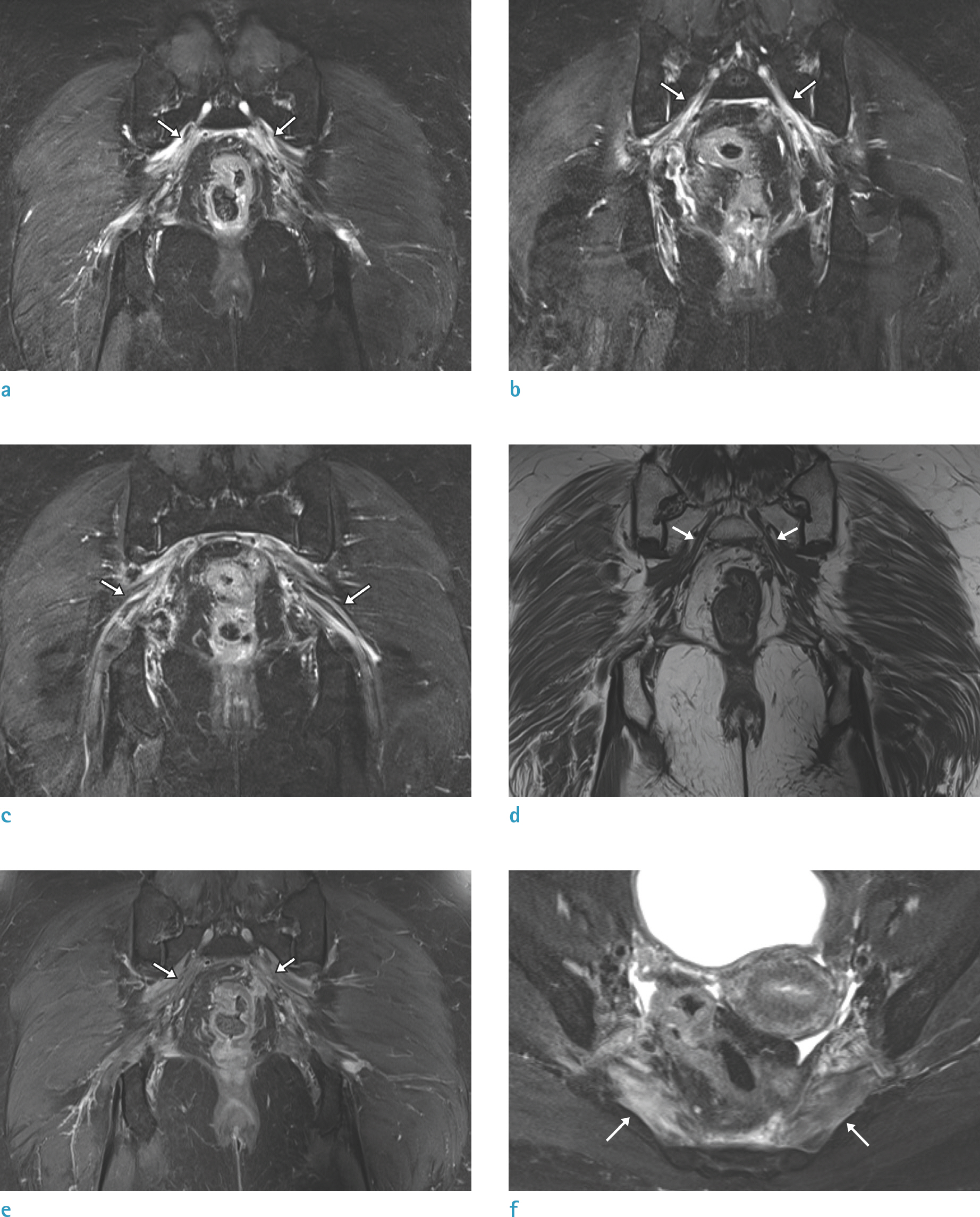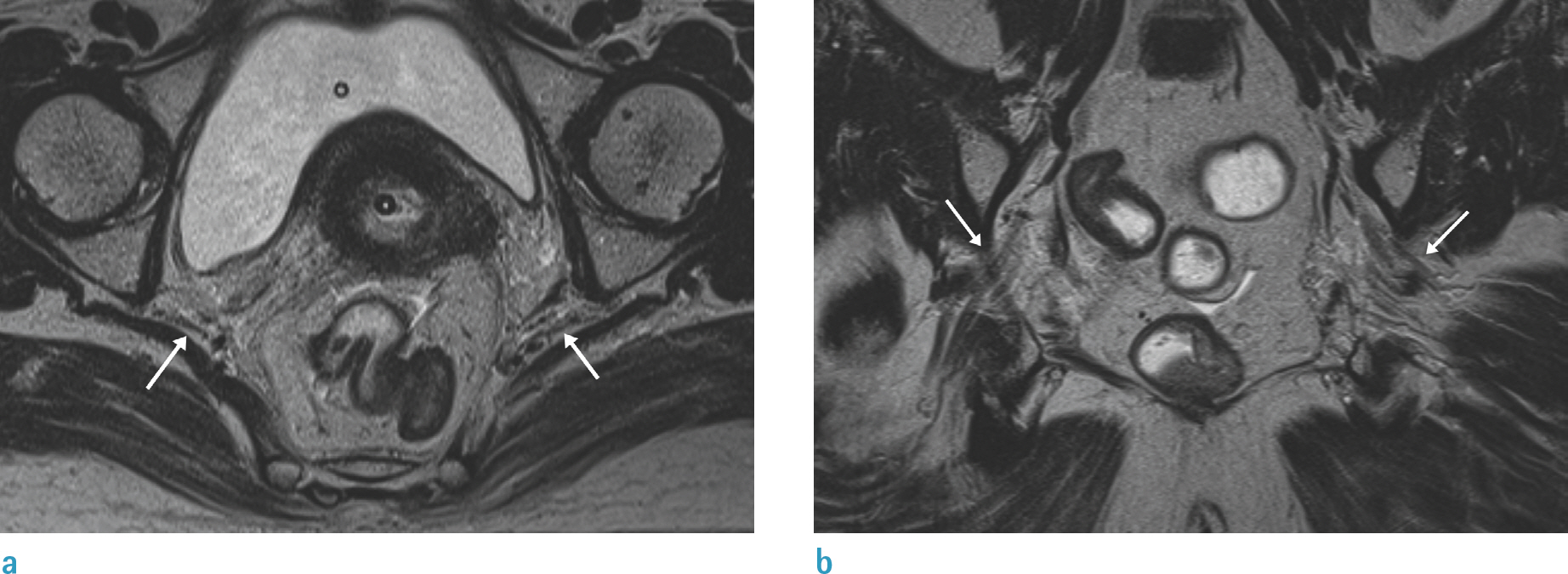Investig Magn Reson Imaging.
2020 Mar;24(1):46-50. 10.13104/imri.2020.24.1.46.
MR Imaging of Radiation-Induced Lumbosacral Plexopathy, as a Rare Complication of Concomitant Chemo-Radiation for Cervical Cancer
- Affiliations
-
- 1Department of Radiology, Yeungnam University College of Medicine, Daegu, Korea
- 2Department of Radiology, Keimyung University School of Medicine, Dongsan Medical Center, Daegu, Korea
- 3Department of Radiology, Kyungpook National University School of Medicine, Daegu, Korea
- KMID: 2508217
- DOI: http://doi.org/10.13104/imri.2020.24.1.46
Abstract
- Radiation-induced lumbosacral plexopathy (RILSP) is an uncommon complication of pelvic radiotherapy that can result in different degrees of sensory and motor deficits. An age 59 female with cervical cancer, who had received combined chemotherapy and radiation therapy two years before, presented with bilaterally symmetric lowerextremity weakness and tingling sensation. The magnetic resonance imaging showed diffuse T2 bright signal intensity and mild enhancement along the bilateral lumbosacral plexus with no space-occupying masses. RILSP was diagnosed after the exclusion of malignant and inflammatory plexopathies.
Keyword
Figure
Reference
-
1.Harper CM Jr., Thomas JE., Cascino TL., Litchy WJ. Distinction between neoplastic and radiation-induced brachial plexopathy, with emphasis on the role of EMG. Neurology. 1989. 39:502–506.2.Taylor BV., Kimmel DW., Krecke KN., Cascino TL. Magnetic resonance imaging in cancer-related lumbosacral plexopathy. Mayo Clin Proc. 1997. 72:823–829.
Article3.Emami B., Lyman J., Brown A, et al. Tolerance of normal tissue to therapeutic irradiation. Int J Radiat Oncol Biol Phys. 1991. 21:109–122.
Article4.Tunio M., Al Asiri M., Bayoumi Y, et al. Lumbosacral plexus delineation, dose distribution, and its correlation with radiation-induced lumbosacral plexopathy in cervical cancer patients. Onco Targets Ther. 2015. 8:21–27.
Article5.Cavanagh JB. Effects of x-irradiation on the proliferation of cells in peripheral nerve during Wallerian degeneration in the rat. Br J Radiol. 1968. 41:275–281.6.Delanian S., Lefaix JL. The radiation-induced fibroatrophic process: therapeutic perspective via the antioxidant pathway. Radiother Oncol. 2004. 73:119–131.
Article7.Denham JW., Hauer-Jensen M. The radiotherapeutic injury–a complex ‘wound’. Radiother Oncol. 2002. 63:129–145.8.Ashenhurst EM., Quartey GR., Starreveld A. Lumbo-sacral radiculopathy induced by radiation. Can J Neurol Sci. 1977. 4:259–263.
Article9.Soldatos T., Andreisek G., Thawait GK, et al. High-resolution 3-T MR neurography of the lumbosacral plexus. Radiographics. 2013. 33:967–987.
Article
- Full Text Links
- Actions
-
Cited
- CITED
-
- Close
- Share
- Similar articles
-
- Radiation-Induced Lumbosacral Plexopathy: Clinical and Electrophysiological Findings in 3 Cases
- A case of recurrent cervix cancer with lumbosacral nerve root metastasis
- Clinical, Electrophysiological Findings in Adult Patients with Non-traumatic Plexopathies
- Chemo-radiation Therapy for Locally Advanced Non-Small Cell Lung Cancer
- Neoplastic Lumbosacral Plexopathy in Untreated Cervical Cancer: A Case Report



